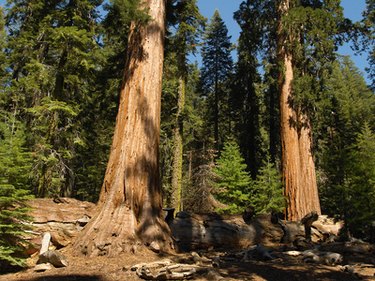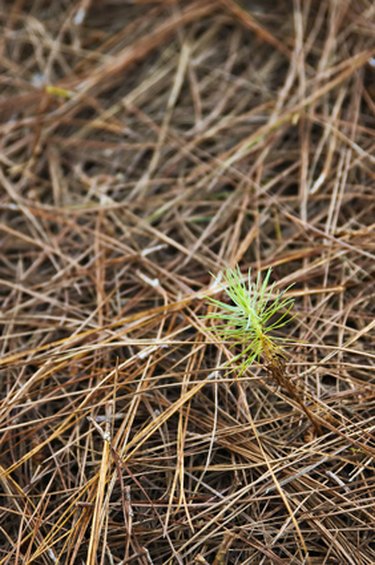
Giant sequoias are the oldest—but not the tallest—living tree on earth. The redwood tops the sequoia in height, but in total volume, the giant sequoias are the largest living things in the world. Sequoias reproduce from the seeds of their cones, and in order to reproduce, these seeds have three requirements: some direct sunlight; an adequate supply of moisture; and soil containing minerals, but no grass or other plants to share the available moisture. Before the seeds can have a chance at reproduction, they must be free of the tough, tight cones.
Flowering, Fruiting and Seed Production
Video of the Day
Sequoias have both male and female flowers—they are monoecious—so both male and female cones form after pollination occurs. The female cones are fertilized in late summer, and seeds begin to form. At the end of the second growing season after fertilization, the female cones mature and produce about 200 seeds each. There have been observations of trees bearing fertile cones as young as 10 years old, but most trees must mature to about 150 to 200 years old before they produce heavy crops of cones.
Video of the Day
Seed Dispersal
Before the small seeds—less than one-half inch in length—can germinate to produce seedlings, they must find their way out of the tough, tight cones. First, the cone must dry out enough so that the scales surrounding the seeds will shrink. Then the seeds must be removed from the cone and dispersed. In the event they land in bare soil and receive enough moisture and filtered sunlight, there is a possibility of germination and growth. Three events, above all others, provide the best possibilities of this happening. Two of these helpful agents are animals.
Phymatodes Nitidus: Long-Horned Wood-Boring Beetle
This beetle is the most productive of the two animals who aid in sequoia seed dispersal. The larvae of this beetle eat away the fleshy cone scales, damaging the structure of the cone. This causes the cone scales to dry and shrink, which allows the seeds to fall. These damaged cones only open a few scales at a time, so six months to a year may pass before most of the seeds have been released to fall to the ground or be carried away by wind.
Tamiasciurus Douglasi: Douglas Squirrel
This squirrel, also called a chickaree, eats the fleshy green scales on young cones. He cuts open and eats the scales but does not bother with the seeds, which are too small to have much food value. The seeds fall to the ground as the squirrel nibbles. The chickaree prefers young cones, 3 to 5 years old, while the Phymatodes beetle larvae searches for older cones. These two animals help provide seed dispersal from cones of all ages.
Release by Fire
The most important agent to aid in the release of sequoia seeds is fire. Whether controlled or wild, fire produces hot air, which travels up through the tree limbs and dries the cones. These dried cones eventually drop from the tree and release their seeds to the ground. The dried cones that remain on the treetops for long lengths of time often release their seeds—which are dispersed by wind—before falling go from the tree.
Seedling Development

Of the millions of seeds shed from their cones, few will meet the conditions for seedling development. Unlike conifer seeds, which may lie on the ground for some length of time and still be viable, the sequoia seeds lose their ability to germinate in a short period. They do not remain dormant, so to survive, they must germinate shortly after landing in favorable conditions. They must have an adequate supply of moisture and they must be protected from drying out with a cover of loose, mineral-rich soil. This location should be in partial shade to reduce surface drying. If all conditions are met, root development will begin.